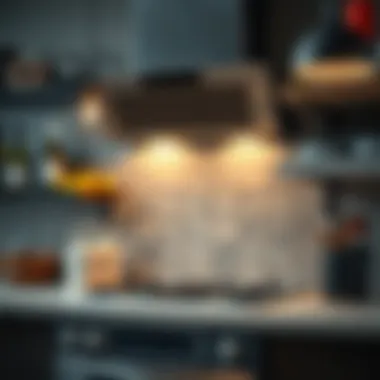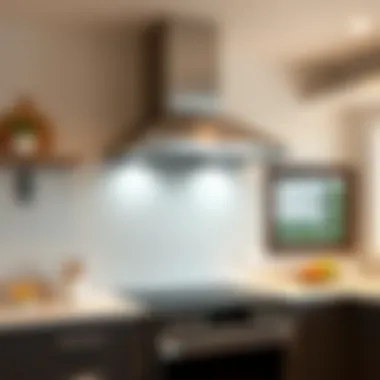Exhaust Fans for Kitchen Stoves: Essential Guide


Intro
In any kitchen setting, ensuring adequate ventilation is more than a mere luxury; it’s a necessity that significantly impacts not just culinary efficiency but also health. Exhaust fans play a pivotal role in this regard, helping to mitigate the buildup of smoke, odors, and moisture that can arise during cooking tasks. They work silently in the background, though their influence on air quality is profound.
Effective ventilation helps maintain a comfortable cooking environment, allowing home chefs to focus on their art without worry. However, choosing the right exhaust fan can be a daunting task, with various options available that differ greatly in function, design, and installation requirements. Understanding these intricacies can empower homeowners, designers, and DIY enthusiasts alike.
Here’s what we’ll cover in this guide:
- Types of exhaust fans suitable for kitchen stoves.
- Key features to consider for optimal performance.
- Best practices for installation to ensure effective airflow.
- Maintenance tips that can extend the life of your exhaust system.
- The significant impact of good ventilation on indoor air quality.
By the end of this article, you’ll be equipped with the knowledge needed to make informed decisions, ensuring that your culinary space is both functional and inviting.
Understanding Exhaust Fans
Exhaust fans are vital components of any modern kitchen, playing a fundamental role in maintaining a clean and healthy cooking environment. By effectively removing unwanted elements such as smoke, odors, and excessive humidity, these fans not only enhance the convenience of cooking but also shield the long-term integrity of your kitchen space. Understanding their functionality is key to choosing the right type for your needs and ensuring optimal performance.
Definition and Purpose
In simple terms, an exhaust fan is an appliance that ventilates kitchens by eliminating smoke, grease, odors, and moisture that accumulate during cooking. The primary purpose of these devices is to improve indoor air quality and provide a healthier atmosphere for cooking and eating. They continuously work to circulate fresh air and expel stale air, which buzzes in the background without much fanfare, yet they wield a significant impact on our daily kitchen experiences.
Benefits of Kitchen Exhaust Fans
Improved Air Quality
Improving air quality is a core benefit provided by kitchen exhaust fans. When cooking, smoke and fumes are generated, which can contain harmful particles. An effective exhaust fan captures these contaminants, keeping the air fresh and breathable. This quality of improved air is particularly indispensable for individuals with allergies or respiratory concerns. Cleaner air contributes not only to health but also enhances the overall culinary experience, allowing home cooks to concentrate on their creations without the distraction of lingering odors.
Odor Elimination
Odor elimination is another laudable feature of kitchen exhaust fans. Cooking up a storm often means that enticing aromas can become overpowering. Without proper ventilation, these smells can linger far longer than desired. A robust exhaust fan efficiently whisks away unwelcome smells shortly after they arise, transforming the kitchen back into a pleasant environment. This makes it a favored choice for those who delight in cooking diverse cuisines, where distinct fragrances can often clash.
Moisture Control
Moisture control stands as an essential aspect of kitchen health. Cooking can introduce significant levels of humidity into the air, which, if unregulated, can lead to problems like mold growth or paint peeling. Exhaust fans play a crucial role in regulating this moisture, ensuring that your kitchen remains dry and more comfortable. This function becomes vital in humid climates where added moisture can manifest issues faster. An effective exhaust fan minimizes such risks, contributing to a healthier kitchen in the long run.
In essence, exhaust fans are not just functional devices; they serve as guardians of the kitchen environment, promoting efficiency and well-being. Their importance in enhancing air quality, eliminating odors, and controlling moisture cannot be overstated.
Types of Exhaust Fans
In the ever-evolving kitchen landscape, the variety of exhaust fans stands as a testament to innovative solutions for air quality and functionality. Understanding the different types of exhaust fans available is crucial for making an informed choice tailored to the specific needs of a kitchen setup. Each type offers unique features and benefits, catering to various preferences, kitchen layouts, and cooking styles, leading to an enhanced cooking environment while improving indoor air quality.
Range Hoods
Range hoods are the unsung heroes of kitchen ventilation. They serve a significant purpose in removing smoke, odors, and airborne grease, thereby transforming the cooking area into a fresher and healthier space. These come in various styles, each with its own flair and functionality.
Wall-Mounted Models
One of the most popular choices is the wall-mounted range hood. These models are designed to be affixed directly above the stove and extend out from the wall, providing an effective barrier against smoke and smells.
A significant characteristic of wall-mounted models is their sleek and modern design, which can complement various kitchen styles—from contemporary to traditional. These units tend to be powerful, offering high airflow capabilities that can efficiently handle the steam and grime released during cooking.
However, they require wall installation, which may not be feasible in every kitchen layout. Their positioning also means that homeowners need to ensure adequate ceiling height to avoid creating a cramped feel.
Under-Cabinet Styles
Under-cabinet styles are another prevalent option, perfect for those who need a more compact solution. These units sit snugly beneath kitchen cabinets, saving valuable space while still delivering effective ventilation.
One key characteristic of under-cabinet fans is their streamlined profile, which can be especially beneficial in small kitchens without much overhead clearance. Additionally, they can offer a good balance between performance and size, making them an attractive option for homeowners focused on maximizing space.
On the downside, it’s essential to ensure compatibility with the cabinet size and style, as it can limit aesthetic options and installation flexibility. In some cases, the suction power may not rival that of larger wall-mounted hoods, which is something to keep in mind based on cooking habits.
Island Range Hoods


For open kitchen designs with an island setup, island range hoods are key players. Designed to hang above the kitchen island, they serve both functional and aesthetic roles.
The standout feature of island range hoods is their ability to create a focal point in the kitchen while effectively removing heat and moisture generated by cooking. They are designed to provide 360-degree ventilation, which is particularly crucial for island configurations where the cooktop is surrounded by open space.
However, island hoods tend to come with a higher price tag compared to other options, and proper installation requires a ceiling height that accommodates a secure fitting without overwhelming the visual space. It's also crucial to ensure sufficient ductwork is in place for maximum effectiveness.
Ductless Fans
Ductless fans are versatile options that operate without the need for extensive ventilation systems. Instead of venting outside, these fans filter the air through built-in charcoal filters, recirculating the cleaned air back into the kitchen.
This type of fan is particularly valuable for renters or those in apartments where ducting may not be feasible. They can effectively remove odors but typically might not handle heavy smoke or moisture as well as ducted systems. Regular filter replacement is necessary to maintain efficiency, and while they can offer a simpler installation process, they may require more frequent maintenance.
Ducted Exhaust Systems
Ducted exhaust systems are the heavyweights in the realm of kitchen ventilators. These systems connect directly to the home’s ductwork, efficiently channeling smoke and odors outdoors.
The primary advantage of ducted systems is their superior performance, especially in kitchens that experience significant cooking. They can also help limit indoor air pollution because they fully vent out stale air rather than recirculating it. However, installation can be more complicated and usually requires professional assistance, making these systems a greater investment both in terms of time and cost.
Key Features to Consider
When diving into the purchase of an exhaust fan for kitchen stoves, understanding the key features is absolutely essential. Selecting the right fan can dictate not only how effectively it functions but also its longevity, maintenance needs, and overall satisfaction in usage. Let’s break down the major features to keep in mind, allowing for an informed purchase that enhances the cooking space.
Airflow Capacity
Airflow capacity is one of the most critical criteria when selecting an exhaust fan. It is generally measured in cubic feet per minute (CFM), indicating how much air the fan can move in a minute. A higher CFM typically translates to more effective ventilation.
Choosing the right airflow capacity depends on the cooking habits and the size of your kitchen. For instance, if you're into frying and searing up a storm, a unit that produces at least 300 CFM might suit you. On the flip side, a casual cook might opt for something around the 200 CFM range. Too little airflow won't sufficiently eliminate cooking odors or heat, while excessive airflow can result in unnecessary energy consumption.
Noise Levels
Noise levels are another major factor. It is important to consider how much hum from the exhaust fan you're willing to tolerate while whipping up a gourmet meal. Noise levels are measured in sones. Generally, the quieter the fan, the more pleasant the cooking experience. You’d probably not want to hear your exhaust fan rumbling like a freight train in the background of your latest culinary masterpiece.
Some fans come equipped with silent or low-noise technology, making them a strong choice for those sensitive to noise. Ideally, a fan that operates at around 1.5 to 3 sones would be acceptable for homes where ambient quietness is desired.
Filter Types
Charcoal Filters
Charcoal filters are pivotal for ductless systems, functioning to absorb odors and keep the kitchen fresh. These filters trap unwanted smells through their highly porous material, making them a popular choice among homeowners. Given the nature of cooking, using charcoal filters can significantly contribute to an improved kitchen ambiance.
However, they do have their downsides. Regular replacement is necessary, generally every 6 months or so, to keep them functioning effectively. Overall, if you're cooking often and want to manage pesky odors without ductwork, charcoal filters indeed stand as a viable choice.
Mesh Filters
Mesh filters are made from layered aluminum or stainless steel, designed to trap grease and particulate from the air. Their construction allows for easy cleaning, as they can often be washed in your dishwasher. Given their durability, they’re favored in many kitchens.
While mesh filters work well for grease, they aren't as effective at absorbing smells. Still, their ease of maintenance provides tremendous convenience to busy households, especially when there’s little time to clean.
Aluminum Filters
Aluminum filters are lightweight and have a long lifespan, making them an appealing option for many consumers. They excel in trapping grease effectively, which helps keep the kitchen cleaner and safer. Their ability to withstand high temperatures is another advantageous feature.
However, one must be cautious, as the lightweight nature can lead to bending or warping over time. Choosing aluminum can be a solid option, along with understanding its proper care to ensure longevity.
In essence, selecting the right features of an exhaust fan requires analysis of one’s cooking patterns, kitchen setup, and personal preferences.
By paying close attention to these elements—airflow capacity, noise levels, and filter types—you ensure that the exhaust fan meets not only your culinary needs but also enhances your overall kitchen experience.
Installation Considerations
When it comes to installing an exhaust fan for your kitchen stove, several vital aspects require careful attention. The proper installation of these fans is crucial, as it directly influences their effectiveness and performance. A well-installed exhaust fan not only improves air quality but also enhances safety and comfort in your cooking space.
Professional Installation vs. DIY


Choosing between hiring a professional or tackling the installation yourself can feel like a high-stakes decision. Each approach has its own set of advantages and drawbacks.
- Professional Installation: Engaging a licensed technician could save you a lot of trouble. Experts have the know-how to navigate complex electrical configurations and ducting. They can spot potential issues that an untrained eye might miss. Besides, should any complications arise, having a professional handle them ensures the job is done correctly and up to code.
- DIY Installation: On the other hand, for the more adventurous souls, installing the fan yourself can be a fulfilling endeavor. With the right tools and guidance, many homeowners find that it’s quite manageable. This route can also save money, which is a big plus. However, it does come with risks, particularly if you're not familiar with electrical work or duct systems. Knowing when to call in a pro is the key here.
Electrical Requirements
The electrical setup is another critical consideration that often gets overlooked. Before diving into installation, familiarize yourself with your kitchen’s wiring. Exhaust fans generally require a dedicated power supply to function efficiently.
- Check your circuit breakers: Make sure the dedicated circuit can handle the fan’s wattage. Overloading circuits can lead to nuisance tripping, which is both annoying and dangerous.
- Wiring compatibility: If you're not used to electrical work, consider consulting a professional. Connecting a fan incorrectly can create fire hazards. Ensuring that your wiring adheres to local codes can save headaches down the line.
Ductwork Requirements
Another aspect that plays a crucial role in the efficiency of your exhaust fan is the ductwork. Depending on the system you choose, you might need to make some adjustments.
- Ducted Systems: If you opt for a ducted exhaust fan, proper ductwork layout is essential. The ducts should be as short and straight as possible. Excess bends can hinder airflow and affect performance.
- Ductless Systems: For ductless systems, make sure that space allows for the necessary filter and fan sizes. Regular maintenance, including filter changes, will also mitigate issues.
In the end, whether you're going the DIY route or hiring a professional, taking the installation seriously is paramount. A well-thought-out installation has the potential to dramatically enhance your kitchen's ventilation effectiveness and, ultimately, your cooking experience.
"A good installation can mean all the difference in how well your exhaust fan works. Don't underestimate the importance of doing it right the first time."
This comprehensive look into installation considerations provides insights that can guide you to make informed decisions, ensuring that your kitchen remains a comfortable and safe environment.
Maintenance of Exhaust Fans
Keeping an exhaust fan in optimal condition is paramount to its effective operation. Regular maintenance ensures not only the longevity of the unit but also promotes better air quality in the kitchen. An exhaust fan that’s well taken care of will function more efficiently, removing smoke, steam, and odors more effectively. Neglecting maintenance can lead to diminished performance, which could negatively affect cooking experiences and indoor air quality. Homeowners often overlook this aspect, but it is crucial for maintaining a fresh and healthy kitchen environment.
Regular Cleaning
Cleaning the exhaust fan should be a routine task, much like doing the dishes or wiping the counters. Grease and grime build up over time, especially if cooking with oil is a regular occurrence. To clean the fan, first, turn it off and disconnect it from power to avoid any accidents.
- Remove the filter: Most exhaust fans have removable filters that can be washed. Depending on the filter type, it may be suitable for the dishwasher or need soaking in a warm, soapy solution.
- Wipe down surfaces: Use a damp cloth with mild cleaner to wipe down the fan’s exterior and any accessible internal parts.
- Check the fan blades: Dust may accumulate on the blades, hindering their ability to create the necessary airflow. A gentle wipe with a soft cloth can help.
- Reassemble and test: Once cleaned, reattach the filter and turn on the fan to ensure everything is operating correctly.
This cleaning routine not only keeps the equipment running smoothly but also contributes to a more pleasant cooking space.
Filter Replacement
Filters in exhaust fans play a key role in capturing unwanted particles and odors. Over time, they become saturated and less effective, similar to changing the oil in a car. For optimal functioning, homeowners should pay attention to their filters and know when to replace them.
- Charcoal Filters: These filters usually need changing every three to six months, as they can lose their odor-absorbing capabilities. If the air in your kitchen starts to smell off, it may be time for a fresh filter.
- Mesh Filters: Made of metal, these can be cleaned and reused but should be replaced if they show signs of discoloration or heavy wear.
- Aluminum Filters: While durable, even aluminum filters wear down when subjected to heat and stains. It's advisable to keep an eye on these for any signs of degradation.
A timely replacement of filters ensures that the exhaust fan can work at peak performance, maintaining clean air in the cooking environment.
Troubleshooting Common Issues
Maintaining the functionality of an exhaust fan means knowing how to troubleshoot when things go awry. Issues often arise, but they can usually be addressed with some basic understanding.
Low Airflow
Low airflow can indicate that the exhaust fan is struggling to perform its primary function, effectively ventilating the kitchen. This issue often arises from dirty filters or ductwork that’s obstructed. If airflow seems diminished:
- Check for blockages in the ducts or filters that could impede the air's movement.
- Inspect for any leaks in the duct system, as they can divert airflow.
If you notice a lack of suction, it is essential to address the problem promptly. Continuing to use a fan that isn’t venting correctly can lead to smoke and moisture accumulating in the kitchen.
Unusual Noises
If your exhaust fan begins to produce unusual noises, it is often indicative of an underlying issue. A fan that normally operates silently shouldn’t suddenly start clattering or grinding. Noises can stem from:
- Loose parts: Over time, screws and components can become loose, causing rattling sounds. A quick inspection can easily resolve this issue.
- Motor problems: A failing motor might create screeching sounds, indicating that professional service could be necessary.
Pay attention to these noises; they can serve as early warning signs for maintenance needs.


Faulty Controls
Sometimes, the controls of an exhaust fan can become unresponsive or act erratically. This can be due to several factors, including:
- Electrical issues: Flickering lights or lack of response from the fan can point to electrical faults that require timely attention. It’s wise to consult with an electrician when faced with such issues.
- Worn switches: Like any mechanical part, controls can wear down. If controls become unresponsive, replacing the switch is often more practical than patching it.
Understanding how to troubleshoot these common issues not only saves time and resources but also ensures that the kitchen remains a safe and pleasant space for cooking.
Impact on Indoor Air Quality
Maintaining a spotless kitchen is more than just an aesthetic choice; it significantly impacts the overall air quality in your home. When cooking, various substances are released, including smoke, steam, and grease, which can accumulate in the air. This not only creates an unpleasant environment but can also lead to respiratory issues and other health complications if left unchecked. Therefore, understanding the role of exhaust fans in promoting indoor air quality is essential for any homeowner.
Importance of Ventilation
Effective ventilation is the cornerstone of a healthy kitchen atmosphere. Exhaust fans serve as critical components in this process by actively removing contaminants generated during cooking. Imagine trying to breathe in a small, stuffy room filled with cooking odors and grease particles; it's hardly pleasant. Here’s what proper ventilation can do for you:
- Reduces kitchen odors: Odors from cooking linger longer without adequate airflow; an exhaust fan eliminates these smells swiftly.
- Removes excess humidity: Cooking produces steam, which can lead to condensation and mold growth if not addressed. Fans help usher moist air out efficiently.
- Enhances air circulation: Adequate airflow supports a more balanced temperature, making your kitchen comfortable and inviting.
Health Implications
Failing to adequately ventilate your kitchen not only affects comfort; it can also have serious health implications for you and your family. Indoor air pollution is a silent but persistent threat, especially in cooking areas. Here is why ventilation should be at the forefront of your kitchen planning:
- Reduces airborne pollutants: Exposure to various pollutants, such as carbon monoxide from cooking gas, can have dire health consequences. Exhaust fans play a pivotal role in maintaining clean air.
- Mitigates potential allergens: Cooking can stir up allergens, like dust and chemicals from cleaning products. Good ventilation helps clear these irritants from the air, promoting better breathing.
- Protects respiratory health: Prolonged exposure to pollutants like smoke and fumes can lead to chronic respiratory diseases. Installing an effective exhaust system is a preventative measure for you and your loved ones.
In light of these factors, the functionality of an exhaust fan transcends basic convenience; it actively contributes to your family’s well-being.
"A kitchen devoid of ventilation is akin to a car running on fumes—eventually, it will sputter and stall."
To sum up, understanding the importance of ventilation and its health implications is key. It’s not merely about having a kitchen that looks good but, rather, having one that promotes good health and well-being.
Trends in Exhaust Fan Design
In the home improvement landscape, exhaust fans for kitchen stoves have seen significant evolution. A few years back, the focus was primarily on functionality alone, but now, aesthetics, sustainability, and technology play major roles. Homeowners and designers alike are eager to integrate these elements alongside traditional performance metrics such as airflow and noise levels. This shift reflects broader trends in both consumer preferences and technological advancements.
Smart Technology Integration
One of the most exciting developments in exhaust fan design is the integration of smart technology. With the rise of smart homes, it’s no jolly surprise that exhaust fans have jumped on the bandwagon. It’s about convenience and efficiency in today’s world, and these fans are no different. Homeowners can now control their exhaust systems remotely through their smartphones. This isn’t just a fancy add-on—there are practical benefits too. Adjusting fan settings can be done from pretty much anywhere, meaning less running around in a chaotic kitchen.
The benefits don’t stop there. Many of these smart models come equipped with sensors that automatically adjust the fan speed based on the cooking conditions. If you’re frying up a storm, the fan can kick into high gear, all without you lifting a finger. Not only does this save energy in the long run, it can also help maintain optimal air quality. Additionally, integration with other smart appliances allows for a more synchronized kitchen environment, leading to better home management overall.
Sustainable Options
As environmental consciousness rises, so does the demand for sustainable kitchen solutions. Exhaust fans that prioritize energy efficiency and sustainable materials are now at the forefront of design trends. It's not just about helping the planet; it can also cut down on utility bills in the long term, which is a win-win scenario.
When considering sustainable exhaust fans, features can include energy-efficient motors and the use of recyclable materials in the construction of the unit. Technologies like variable speed motors help keep energy consumption low while still maintaining excellent ventilation when it’s needed the most. Furthermore, many manufacturers are moving towards greener production processes, thus reducing the overall carbon footprint of their products.
In summary, the marriage of sustainability and style in exhaust fan design doesn't merely fulfil a need for effective kitchen ventilation—it addresses the sensibilities of a conscientious consumer base, ensuring that efficiency doesn’t come at the expense of environmental responsibility.
Investing in an exhaust fan with smart technology not only enhances convenience, it significantly improves energy efficiency and overall kitchen air quality.
For further insights into smart technology and sustainable designs, visit Wikipedia or Britannica for a broader perspective on current trends in home improvement.
Ending
The conclusion of any comprehensive article serves as the crux that ties all threads together. In this case, understanding exhaust fans for kitchen stoves is vital, not only for improving functionality but also for fostering a healthier living environment. When choosing an exhaust fan, several paramount elements should be considered.
Summary of Key Points
- Variety of Types: From range hoods to ductless fans, each type serves specific needs, influencing both style and performance in the kitchen.
- Installation Matters: Whether opting for professional help or a DIY approach, knowing the installation requirements can greatly affect your choice and subsequent effectiveness of the fan.
- Maintenance is Key: Regular cleaning and understanding filter types ensure the longevity and efficiency of your exhaust fan. Keeping filters changed regularly reduces the risk of being plagued with poor air quality.
- Impact on Air Quality: Proper ventilation not only eliminates unwanted odors and moisture but also contributes positively to the overall indoor air quality. Having an efficient exhaust fan can reduce the chances of respiratory issues and other health concerns.
Final Thoughts on Choosing an Exhaust Fan
Picking the right exhaust fan isn’t just about style; it’s about making an informed decision that aligns with your kitchen's specific needs. Think about your cooking habits—do you stir-fry regularly? A high-efficiency fan might suit you better than a conventional model. Moreover, always consider energy efficiency, sound levels, and filter types that best fit your lifestyle.
With new trends tackling sustainability and smart technologies, it's an exciting time for homeowners considering an upgrade. Innovation ensures that exhaust fans are not only highly effective but also eco-friendly. Ultimately, investing in a good exhaust fan is investing in your health, comfort, and kitchen experience.
"The kitchen is the heart of the home; ensuring clean air is just as essential as the food being prepared."
For more information on keeping your kitchen air quality high, resources like EPA provide comprehensive coverage on ventilation benefits.















